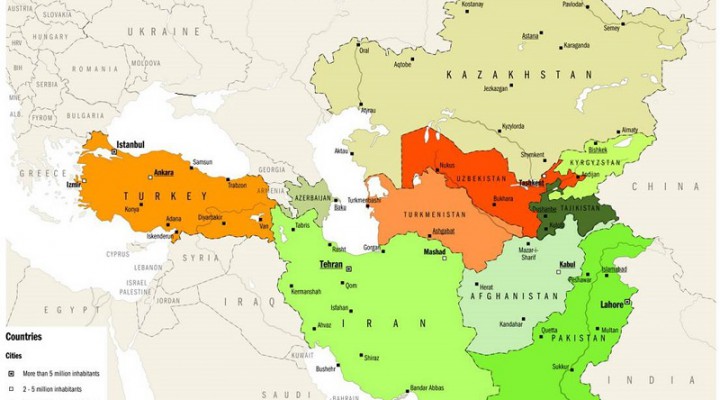The Economic Cooperation Organization & BRI Complement One Another

China’s BRI investments in many of these member states have resolved their prior transportation challenges and thus given them the chance to finally fulfill their full potential if they have the will to do so.
The 15th Economic Cooperation Organization (ECO) leader’s summit was held in the Turkmen capital of Ashgabat late last month. This group brings together Afghanistan, Azerbaijan, Iran, Kazakhstan, Kyrgyzstan, Pakistan, Tajikistan, Turkey, Turkmenistan, and Uzbekistan. It’s one of the most promising integration formats in Eurasia but hasn’t yet come anywhere close to reaching its full potential. That’s because of the two-decade long US occupation of Afghanistan and lack of connectivity infrastructure.
The American withdrawal from Afghanistan revolutionized the regional geo-economic and geostrategic situation. It also came as three regional connectivity projects continued to mature into viable East-West transport corridors. These are the Belt & Road Initiative’s (BRI) flagship project of the China-Pakistan Economic Corridor (CPEC), the China-Central Asia-West Asia Economic Corridor (CECWAEC), and the Middle Corridor between China and Turkey via Central Asia and the South Caucasus.
The first two are formally part of BRI while the last can be regarded as unofficially part of this global connectivity network. There’s also the potential for a China-Tajikistan-Afghanistan-Iran corridor too, which is being advanced by Beijing’s investments in Tajikistan’s eastern roads. Furthermore, CPEC could be expanded westward through the W-CPEC+ vision to connect with the Islamic Republic. That country is so important to China since the two reached a 25-year strategic partnership deal earlier this year.
With these observations in mind, two developments can be described as breathing fresh life into this organization: the American withdrawal from Afghanistan and Chinese-led Eurasian integration investments through BRI and those projects that are related to it like the Middle Corridor and the prospective Trans-Afghan Corridor. These provide a solid basis upon which the ECO can finally begin to fulfill its promising potential considering the new regional geo-economic and geostrategic reality.
Nevertheless, even with the American withdrawal from Afghanistan, the ECO would still struggle to surmount its greatest challenge had it not been for BRI’s regional investments over the past few years. The lack of transport infrastructure handicapped this organization and served as the top obstacle to comprehensively expanding relations between its many diverse majority-Muslim members. China literally changed the game through BRI, which thus inspires hope for the ECO’s future.
This bloc should concentrate on several interconnected objectives. First, it must ensure that the situation doesn’t spiral out of control in Afghanistan. To this end, its members can not only promise to deliver much-needed humanitarian aid, but also propose various investment projects that could sustainably unlock its economic potential upon its ultimate stabilization. The Lapis Lazuli Corridor, for instance, could connect with CPEC and be invested in by Pakistan, Turkmenistan, Azerbaijan, and Turkey.
Second, the ECO countries need to work towards harmonizing their customs regimes, which is easier said than done since Turkey is an aspiring EU member while Kazakhstan and Kyrgyzstan are part of the Russian-led Eurasian Economic Union (EAU). Nevertheless, they must find practical ways to facilitate trade and investment between them otherwise they’ll never reach the full potential that they’re destined to achieve.
Third, there are concerns among some ECO members that expanding trade ties with Iran could prompt the imposition of the US’ threatened unilateral secondary sanctions in response. This has enormously held back the bloc’s comprehensive integration but hopefully its members can agree on a blueprint for what to do in the event that Washington and Tehran successfully renegotiate the nuclear deal and these economic-financial deterrents are no longer a factor like predict might eventually happen.
Fourth, efforts should be undertaken to optimize relevant transregional connectivity projects, both existing ones like CPEC and potential projects like the Trans-Afghan Corridor between China and Iran. This can be done by brainstorming ways in which they can be expanded, paired with one another, and the larger role that they’re expected to play in the ECO’s workings, both as an organization and also with respect to each member state’s economies.
And fifth, the ECO members should seriously consider the wisdom of inviting China to become either a dialogue partner or observer. The modalities for granting such are already met by the People’s Republic in accordance with what’s written on the organization’s website. The ECO would immensely benefit by establishing some formal relations with China considering the fact that their goals are complementary with BRI’s and Chinese investments in these countries have breathed new life into this bloc.
All told, there are high hopes that this year’s leadership summit will tangibly advance the ECO’s integration goals considering the new geo-economic and geostrategic reality in which these countries are meeting following the American withdrawal from Afghanistan. More importantly, though, China’s BRI investments in many of these member states have resolved their prior transportation challenges and thus given them the chance to finally fulfill their full potential if they have the will to do so.
 TheAltWorld
TheAltWorld 
0 thoughts on “The Economic Cooperation Organization & BRI Complement One Another”